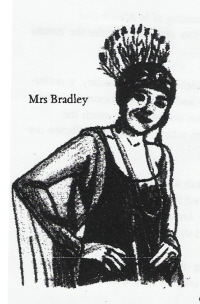Occasional Mentions of Brentford in Literature
The Mrs Bradley Mysteries on BBC
The dramatisation of Gladys Mitchell's detective novels, "The Mrs Bradley Mysteries" are currently showing on BBC4 (Wednesdays, 9pm), starring Diana Rigg. Readers may be interested in the following article about Gladys and her links with Brentford that was published in the Sundial (the parish magazine of All Saints Church, Isleworth) back in November 1998.
Gladys Mitchell was educated locally, first at the Brentford British School and then at the Green School. The Brentford British School was a Victorian, creeper covered building, with tall windows, much more attractive than the Health Centre that has replaced it.
Gladys became a pupil at the Green School in
September 1913, when there were 150 girls and seven mistresses (including the
headmistress). The Vicar of Isleworth visited on Monday mornings to give a lesson on
the Book of Common Prayer.
In the “Old Girls” News Sheet 1976-7, Gladys describes how, until they reached the
Lower Fifth form, they had to wear green overalls on top of their gym slips. This, she
thought, gave them the appearance of charity schoolchildren, and this was emphasised
when the Vicar, Rev Mr McGill, suggested that the girls should curtsey to him when he
visited on Monday mornings. The suggestion was not received with enthusiasm and was
never carried out.
In Miss Mitchell’s day, very few of the girls sat for Public Examinations, as the Green
School was not geared to them. In her own time, in 1918, only two girls sat the
Matriculation exam and one took General Schools, and they all passed. To matriculate,
a pass was required in five subjects.
There were no open days and no prize giving as the school was non-competitive.
There were school concerts and plays which were usually based on some aspect of the
work they were doing.
After the Green School, Gladys studied at Goldsmiths and University Colleges. Between
1921 and 1950 she taught at St Paul's School, Brentford, St Anne's Senior Girls School,
Ealing and the Brentford Senior Girls’ School. Her subjects were English, History and
Games.
Her first novel was published in 1929 when she was teaching at St Anne's and
she went on to publish a book a year until her death. She also wrote under the names
of Stephen Hockaby and Malcolm Torrie.
All her books under her own name featured Beatrice Adela Lestrange Bradley, a rather
bizarre detective who was also a psychoanalyst, author and holder of honorary degrees
from many universities. She later became Dame Beatrice and was very much the
professional woman with progressive views for the time, which, I imagine, reflected the views of Gladys Mitchell herself.
Miss Mitchell was an early member of the Detection Club and often satirised the
traditional patterns of detective story writing. She retired from teaching in 1950, but
became bored and accepted a position at the Matthew Arnold School in Staines and
taught there from 1955 to 1961. She finally retired and then moved to Dorset.
At least two of her books were set in Brentford during the 19305, and it is fascinating
to read of the town when Boston Manor Road was a country lane with hedges on
either side.
In "The Rising of the Moon" she describes the High Street with the many alleys leading
from it to the docks and riverside. The alleys were lined with small old houses, stables,
mills, repair shops and smithies, all tucked away behind the High Street which was the
most congested bottleneck out of London. There is also a description of the High Street
further west, where it crossed the canal with more alleys and a "complication” of
riverside houses, which made a town inside the town of Brentford, and where the
inhabitants had nothing to do with the rest of the population. This was known as Old
England, and strangers were not welcome. The Leys was the oldest pan of Old England 5 nearest the High Street. Was this the area now known as Brent Lea or even the
residential area leading from Augustus Close? It would be interesting to hear from any
readers who have memories of an older Brentford.
Pat Buckingham
With many thanks to Carolyn Hammond of Chiswick Library and Kevin Brown for their
help and enthusiasm.
If you would like to contribute to this series of articles looking at Brentford in Literature, or write book reviews, please contact the editor
March 1, 2012
Related links
|
